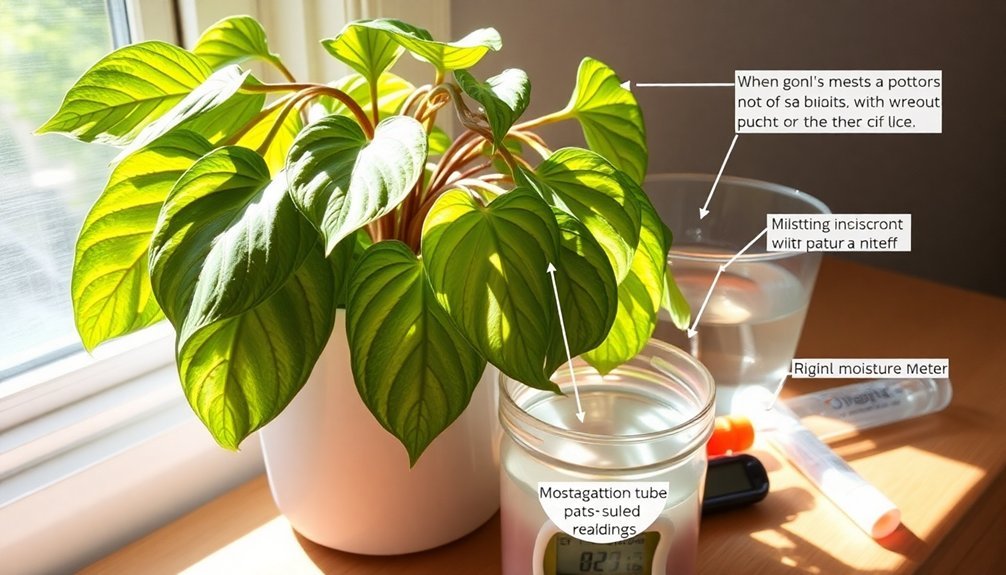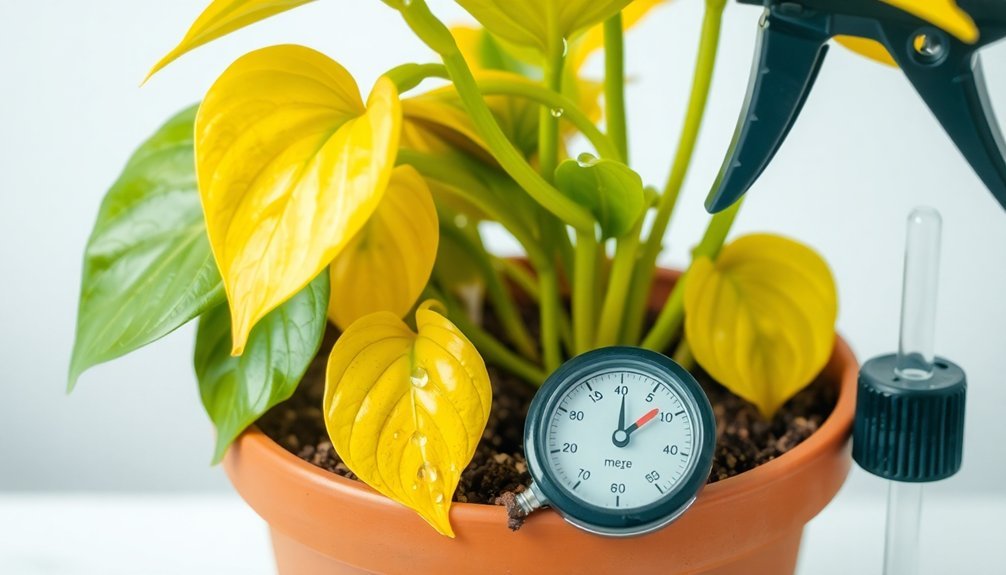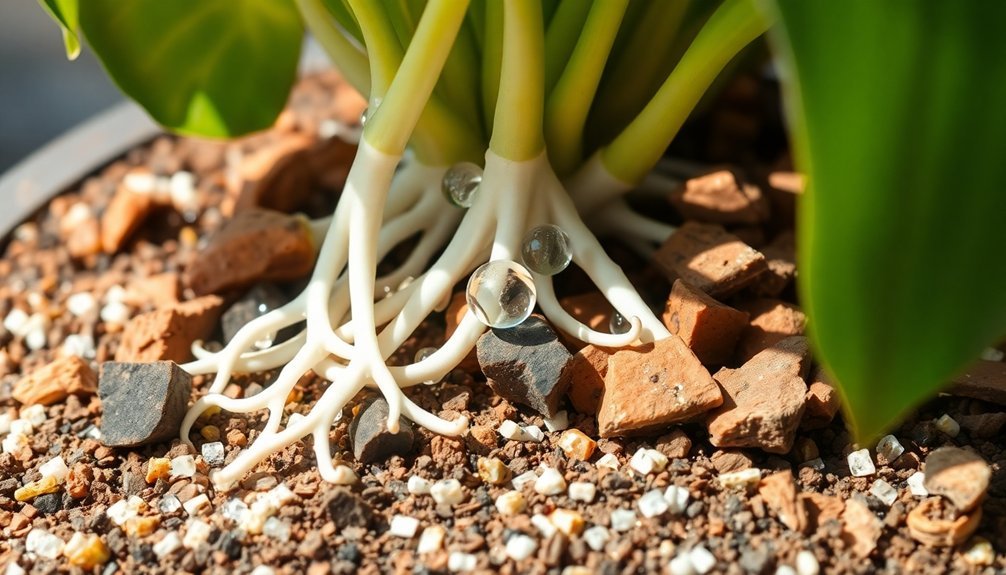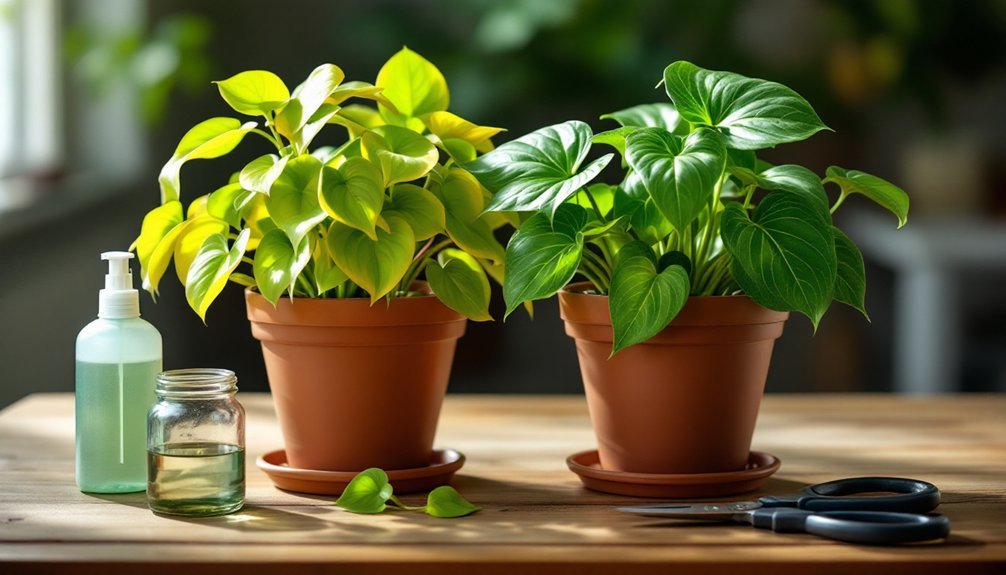To save your wilting pothos, first check the soil moisture by inserting your finger 2-3 inches deep. If it's dry, submerge the pot in room-temperature water for 1-2 hours; if soggy, remove the plant and inspect for root rot. Place your pothos in bright, indirect light and maintain temperatures between 70-90°F. Trim yellow leaves and guarantee proper drainage. Your plant's revival journey has just begun, with many more rescue techniques to explore.
Common Signs of a Distressed Pothos

A struggling Pothos will display several telltale signs that you shouldn't ignore. When you notice yellowing leaves, it's often a warning that you're either overwatering your plant or it's lacking essential nutrients.
Droopy leaves signal a watering imbalance – your plant's either thirsty or drowning from excess moisture that could lead to root rot.
Watch for wilting, which can stem from poor soil conditions, root issues, or sudden temperature changes.
A wilting Pothos sends a clear distress signal – check your soil quality, examine the roots, and maintain consistent temperatures.
If you're seeing stunted growth, your Pothos likely isn't getting enough light or nutrients to thrive.
Pay attention to leggy stems with sparse foliage, as this indicates your plant's desperately searching for more light. You'll need to adjust its location or provide additional lighting to help it recover.
Quick Assessment of Wilting Causes
Once you've spotted signs of distress in your Pothos, performing a quick diagnostic check can pinpoint the exact cause of wilting. Check these common issues to identify what's causing your leaves to droop:
| Problem Sign | Quick Check |
|---|---|
| Root rot | Feel soil for sogginess; look for yellow leaves |
| Soil is dry | Test top 2-3 inches for moisture |
| Temperature stress | Check for drafts or direct sun exposure |
| Pest problem | Look for webbing or sticky residue |
| Root bound | Examine if roots circle pot's bottom |
Don't wait to investigate when your plant shows distress. These quick checks will help you identify the issue immediately, letting you take appropriate action before the problem worsens. Remember that proper diagnosis leads to effective treatment, ensuring your Pothos returns to its vibrant self.
Emergency Watering Techniques

When your Pothos shows signs of severe dehydration, you'll need to act quickly with targeted emergency watering methods. The most effective emergency watering technique is to submerge the entire pot in room-temperature water for 1-2 hours, allowing deep soil hydration.
To water your Pothos efficiently, place the nursery pot in a bucket with 2 inches of water, enabling bottom-up absorption. Don't forget to let it drain completely afterward to prevent root rot.
If you're planning to be away, consider using watering globes for consistent moisture delivery.
Monitor your plant's needs by checking the top 2-3 inches of soil – when it's dry, it's time to water. Maintaining proper drainage is essential; never let water pool at the bottom of your pot, as this can harm your plant's roots.
Root Health Evaluation Steps
To guarantee your pothos thrives, regularly checking its root system serves as a crucial health indicator.
Start by carefully removing your plant from its pot and examine the roots – they should be firm and light-colored. If you spot dark, mushy sections or detect an unpleasant smell, you'll need to trim these damaged areas using sterilized scissors.
Test the soil moisture by giving it a gentle squeeze; it should feel like a damp sponge, indicating proper watering levels.
If you notice roots circling tightly around the pot's interior or creating a dense mass, it's time to repot into a larger container.
When replanting, use fresh, well-draining potting soil to prevent future root issues and ensure ideal drainage.
This evaluation process helps maintain healthy root development and supports your pothos' overall growth.
Temperature and Light Adjustments

Since temperature and lighting conditions directly impact your pothos' health, making the right adjustments can quickly revive a wilting plant.
Keep your pothos in areas with stable temperatures between 70-90°F, and move it away from cold drafts or winter windows where temperatures might dip below 50°F.
Position your plant in bright, indirect light to prevent leaf scorching while ensuring it gets enough light for healthy growth.
If you notice wilting leaves, first check if your pothos is too close to cold air sources or receiving direct sunlight. Relocate it to a spot with consistent temperatures and filtered light.
To combat dry indoor air that may contribute to wilting, try misting the leaves regularly.
These simple environmental adjustments often resolve wilting issues quickly.
Pest Inspection and Treatment
Beyond temperature and light issues, pest infestations can cause your pothos to wilt and deteriorate rapidly.
You'll need to inspect your plant's leaves and stems regularly, looking for telltale signs like webbing, sticky residue, or visible insects. Pests like spider mites can quickly take over if left unchecked.
If you spot an infestation, immediately isolate the affected plant from your other houseplants. Treat the problem using insecticidal soap or neem oil according to the product's instructions.
Don't skip any recommended follow-up treatments, as some pests require multiple applications for complete elimination. Make pest inspection part of your bi-weekly plant care routine, and monitor the plant's recovery closely after treatment.
Early detection and swift action are your best defenses against pest-related wilting.
Soil Moisture Management Tips

While many plant problems can be traced back to improper watering, managing soil moisture for your pothos doesn't have to be complicated. Simply check if the soil feels dry by inserting your finger 2-3 inches deep. When it's dry at this depth, it's time to water.
| Action | Timing |
|---|---|
| Check soil moisture | Every 3-4 days |
| Let the soil dry | Between waterings |
| Follow watering schedule | Every 1-2 weeks |
Using well-draining soil is essential for your pothos' health. Mix in moisture-retaining materials like perlite or coconut coir to create the perfect balance. Consider bottom watering as an effective technique – place your pot in a water-filled tray and let the roots drink deeply. This method encourages stronger root growth while preventing overwatering issues.
Humidity Level Optimization
Although Pothos can survive in average home conditions, they'll truly flourish in higher humidity environments that mirror their tropical origins. To boost humidity levels to the ideal 50-70% range, you'll want to implement several effective strategies.
Start by grouping your Pothos with other plants to create a natural microclimate through shared transpiration. Regular misting works well, especially when your home feels dry from heating or air conditioning.
For a low-maintenance solution, place a tray of water filled with pebbles under your Pothos pot – the evaporating water will provide consistent moisture without risking root rot. If you're dealing with persistently low humidity, particularly during winter months, consider running a humidifier near your plant to maintain perfect moisture levels.
Root Rot Prevention Methods

Watch for early signs of root rot like yellowing leaves and a musty odor, and inspect your plant's roots regularly for dark, mushy spots.
You'll need proper drainage materials, including pots with sufficient holes and a well-aerated potting mix containing perlite or orchid bark.
Keep track of your watering schedule, only adding moisture when the top few inches of soil feel dry, as overwatering is the primary cause of root rot in Pothos plants.
Identify Early Warning Signs
Spotting early signs of root rot in your pothos can mean the difference between saving and losing your plant. Watch for yellowing leaves and soggy soil, as these symptoms often appear before severe damage occurs. Check your pot's drainage holes regularly to guarantee proper water flow.
| Warning Sign | Action Required |
|---|---|
| Yellow Leaves | Reduce watering frequency |
| Mushy Soil | Check drainage holes |
| Dark Roots | Trim affected areas |
| Foul Odor | Replace soil immediately |
You'll want to inspect your plant's roots periodically – they should be firm and white, not dark and mushy. Don't water until the top 2-3 inches of soil feel dry to the touch. If you notice any issues, switch to a well-draining potting mix with added perlite to improve aeration and prevent future root rot problems.
Choose Proper Drainage Materials
When it comes to preventing root rot, selecting the right drainage materials is essential for your pothos' survival. Your plant's root health depends on proper water flow and soil aeration.
Start by ensuring your pot has adequate drainage holes and use a well-draining potting mix enhanced with perlite or vermiculite.
Here's what you'll need for ideal drainage:
- Bottom layer: Small stones or gravel to facilitate water flow
- Main mix: Quality potting soil combined with perlite
- Moisture meter: To check soil moisture level before watering
- Fresh materials: New soil mix every 2-3 years during repotting
Monitor Watering Frequency Carefully
Three key factors determine proper watering frequency for your pothos: soil moisture, environmental conditions, and drainage efficiency.
You'll need to check the top 2-3 inches of soil before watering. If it feels dry, it's time to water your plant. In low-light areas, limit watering to less than once per week to prevent overwatering.
Your pot must have drainage holes to let excess water escape, reducing the risk of root rot.
Watch for warning signs: soggy soil indicates you're overwatering, while completely dry soil means your plant needs water.
If you notice root rot symptoms, act quickly by removing the plant, trimming damaged roots, and repotting in fresh, well-draining soil.
This monitoring system helps maintain the perfect moisture balance for your pothos's health.
Pruning and Propagation Solutions
Strategic pruning and propagation offer powerful solutions for bringing your wilting Pothos back to vibrant health.
Remove yellowing leaves with clean, 45-degree angle cuts to encourage stronger growth and improve your plant's appearance. You'll find that careful pruning stimulates new growth while preventing disease spread.
- Cut healthy stems with at least two leaves for propagation
- Place cuttings in water or soil to encourage root development
- Watch for roots to reach 2-4 inches before transplanting
- Time propagation during spring and summer for best results
While you can propagate year-round, your cuttings will thrive best during the natural growing season.
Essential Recovery Care Schedule
To restore your wilting Pothos to full health, following a consistent recovery care schedule is essential.
A consistent care routine is the key to bringing your struggling Pothos back to its vibrant, healthy state.
Check your watering routine by inserting your finger 2-3 inches into the soil every few days, and water thoroughly only when it's dry. You'll want to maintain temperatures between 65-80°F and humidity levels of 50-70% for best recovery.
The good news is that your Pothos thrives when you establish a proper care rhythm.
Every week, inspect the plant for pests and treat any issues with insecticidal soap or neem oil. Trim away yellowing or dead leaves to promote new growth.
If you notice signs of overwatering, immediately remove the plant from its pot and let it dry completely. Consider repotting in fresh, well-draining soil if you spot root rot.
Long-Term Maintenance Strategies
Maintaining your pothos long-term requires a balanced approach that goes beyond basic recovery care. The key is establishing consistent routines that promote healthy growth and prevent future wilting issues.
- Choose a well-draining potting mix and repot every 2-3 years to prevent root congestion, giving your plant room to thrive.
- Position your pothos in indirect sunlight and maintain temperatures between 70-90°F to create ideal growing conditions.
- Apply houseplant fertilizer during active growing seasons and prune away damaged leaves to encourage new growth.
- Monitor soil moisture by checking the top 2-3 inches weekly, adjusting your watering schedule based on environmental conditions.
Remember to inspect your plant regularly for signs of pests or disease, treating any issues promptly with appropriate solutions to maintain your pothos's long-term health.
Natural Growth Support Methods
Supporting your wilting Pothos through natural methods requires understanding the plant's inherent growth patterns and environmental needs. Don't water the plant until the top 2-3 inches feel dry, and never let the soil get soggy. Implement humidity-boosting methods by misting leaves or using a humidifier to maintain ideal moisture levels.
| Action | Benefit |
|---|---|
| Check soil moisture | Prevents overwatering |
| Use well-draining potting mix | Promotes root health |
| Maintain 50-70% humidity | Encourages leaf recovery |
| Apply half-strength fertilizer | Supplies essential nutrients |
| Monitor for pests | Prevents stress damage |
When you follow these natural support methods, you'll create an environment where your Pothos can thrive. Remember to regularly check the soil's moisture level and adjust your care routine based on your plant's response to these interventions.
Frequently Asked Questions
How to Revive Wilted Pothos?
First check soil moisture with your finger. If it's dry, soak the pot for an hour. If it's soggy, repot with fresh soil. Place in bright indirect light and maintain regular watering schedule.
How Do You Revive a Dying Pothos Plant?
Check your soil's moisture first. If it's dry, water thoroughly; if soggy, repot with fresh soil. Trim rotted roots, maintain temps around 70-90°F, and treat any pests. You'll see improvement within weeks.
How to Revive Overwatered Pothos?
Remove your Pothos from its pot, trim rotted roots, and let it dry out. Repot in fresh, well-draining soil with proper drainage holes. Water sparingly, waiting until top soil's dry before watering again.
How to Nurse a Pothos Back to Health?
First, check your Pothos' soil moisture and adjust watering. Place it in bright, indirect light, trim damaged leaves, maintain warm temperatures, and boost humidity. Watch for new growth as it recovers.
In Summary
You'll find reviving your wilting pothos isn't as challenging as it seems. Follow these proven steps – from proper watering to light adjustments – and you'll see positive changes within days. Stay consistent with your care routine, monitor for signs of improvement, and don't forget to maintain ideal growing conditions. With patience and attention, your pothos will bounce back to its lush, vibrant self.





Leave a Reply